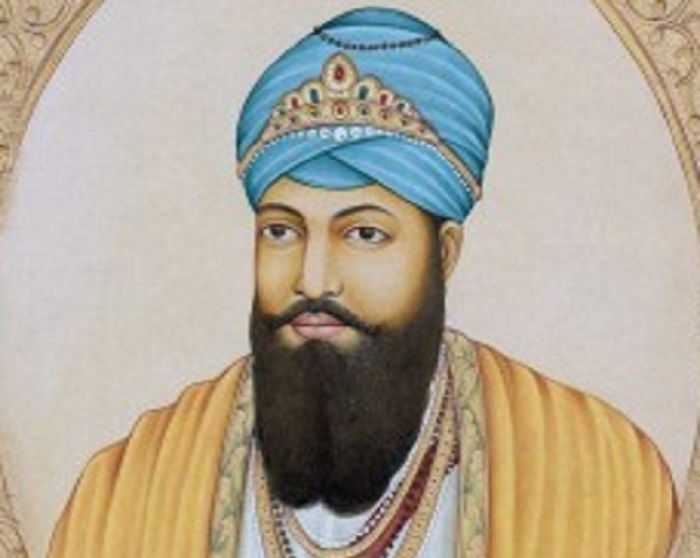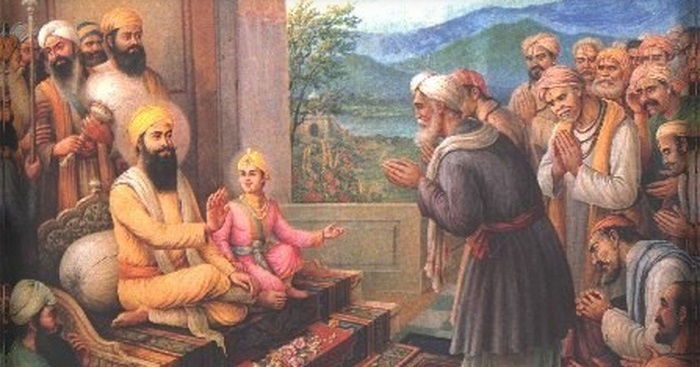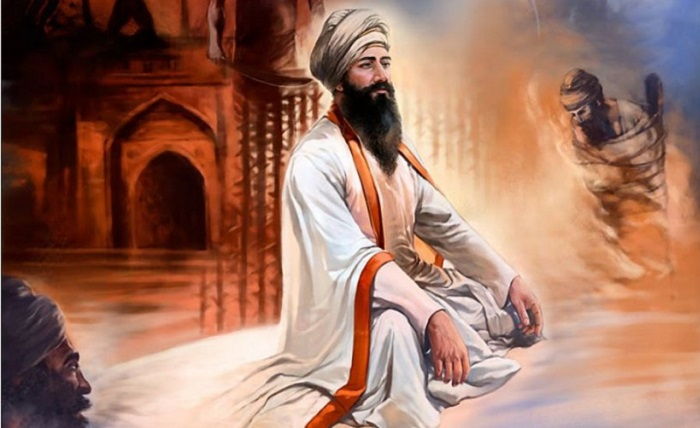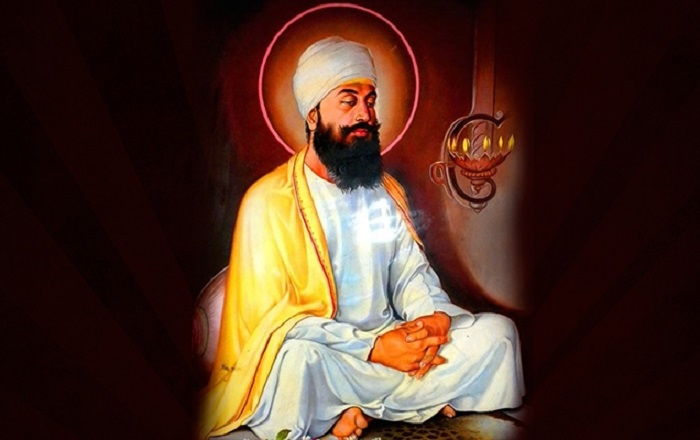Facts
Birth: 1 April 1621
Place: Amritsar, Punjab, Mughal Empire
Death: 24 November 1675
Place: Delhi, Mughal Empire
Father: Guru Har Gobind
Mother: Mata Nanaki
Spouse: Mata Gujri
Predecessor: Guru Har Krishan
Successor/Son: Guru Gobind Singh
Guru Tegh Bahadur was the ninth Sikh Guru, often venerated as the ‘Protector of Humanity’ (Srisht-di-Chadar) by the Sikhs. Known as a great teacher, Guru Tegh Bahadur was also an excellent warrior, thinker, and poet, who wrote detailed description of the nature of God, mind, body, and physical attachments among other things spiritual. His writings are housed in the sacred text, ‘Guru Granth Sahib,’ in the form of 116 poetic hymns. He was also an avid traveler and played a key role in setting up preaching centers throughout the Indian subcontinent. During one such mission, he founded the town of Chak-Nanki in Punjab, which later became a part of Punjab’s Anandpur Sahib. In 1675, Guru Tegh Bahadur was forced by the then Mughal Emperor Aurangzeb to give up his faith and convert to Islam. When he refused, the Sikh Guru was beheaded on November 24, 1675, in Delhi.

Image Credit : https://www.thefamouspeople.com/profiles/guru-tegh-bahadur-6761.php
Early Life
Guru Tegh Bahadur was born Tyag Mal on April 1, 1621, in Amritsar, Panjab. He was born to the sixth Sikh Guru, Guru Hargobind, and his wife, Mata Nanaki. As a child, Tyag Mal learnt Sanskrit, Hindi, and Gurmukhi from the revered Sikh scholar, Bhai Gurdas. While horsemanship and archery was taught to him by Baba Buddha ji, Guru Hargobind taught him swordsmanship.
When Tyag Mal was just 13 years old, he accompanied his father to a battle against the Mughals, who had laid siege to Kartarpur. Thanks to Guru Hargobind and Tyag Mal, Kartarpur was successfully defended by the Sikhs. For exhibiting great valor and military skills in the battle, Guru Hargobind bestowed upon his son the title ‘Tegh Bahadur,’ which literally means ‘brave sword wielder.’ Tyag Mal henceforth came to be known as Tegh Bahadur.
In 1632, Tegh Bahadur got married to Mata Gujri. By now, Tegh Bahadur had begun to spend much of his time in meditation and had gradually secluded himself. In 1644, Guru Hargobind asked Tegh Bahadur to move to a village, Bakala, along with his wife and his mother. The next two decades saw Tegh Bahadur spend most of his time meditating in an underground room in Bakala, where he would later be recognized as the ninth Sikh Guru. During his stay in Bakala, Tegh Bahadur traveled extensively and even visited Delhi to meet Guru Har Krishan, the eighth Sikh guru.
Guruship
In 1664, Guru Har Krishan’s health was badly affected by smallpox, which ultimately led to his death on March 30, 1664. While on his death bed, Guru Har Krishan was asked who would be his successor to which he simply uttered the words ‘Baba’ and ‘Bakala,’ which implied that the next Guru would be found in Bakala. When the word about the next Sikh Guru spread, many imposters settled down in Bakala and claimed to be the next Guru for monetary and other trivial gains. This led to confusion among the Sikhs as it made the task of finding the real Sikh Guru very difficult.
Meanwhile, a wealthy trader named Baba Makhan Shah Labana had once been caught in a powerful storm, which had almost capsized his ship. During the incident, Baba Makhan Shah felt helpless and hence prayed to God that he would offer 500 gold coins to the Guru, should he be saved from the storm. After being saved miraculously, Baba Makhan Shah went in search of Guru Har Krishan, when he was informed about the passing of the Guru. He was also informed that Guru Har Kishan had professed that the next Guru will be found in Bakala.
When Baba Makhan Shah Labana arrived in Bakala on August 1664, he was surprised to see as many as 22 imposters claiming to be the ninth Sikh Guru. Baba Makhan Shah recalled his prayer and then started giving away two Dinars to every imposter. As expected, all the imposters walked away happily after receiving two Dinars. Baba Makhan Shah, who was disappointed for not having met the real Guru, was taken to Tegh Bahadur on August 10, 1664. Upon seeing Tegh Bahadur, Baba Makhan Shah placed two Dinars before him, for which Tegh Bahadur replied by saying, ‘why two when you pledged 500?’ Upon hearing those words, Baba Makhan Shah placed 500 gold coins before Tegh Bahadur and started yelling with excitement, ‘Guru ladho re’ (I have found the Guru). Henceforth, Tegh Bahadur was declared as the ninth Sikh Guru.

Image Credit : https://scroll.in/article/827788/the-tale-of-guru-tegh-bahadur-and-aurangzeb-embodies-the-simplification-of-sikh-mughal-history
Works
Guru Tegh Bahadur started traveling to various parts of the country in order to preach the teachings of the first Sikh Guru, Guru Nanak. He also started spreading the message of Sikhism, while helping those in need. In 1664, Guru Tegh Bahadur visited Kiratpur thrice for three different reasons. During his first visit on August 21, 1664, the Guru met with Bibi Rup, the daughter of the seventh Sikh guru, who was mourning the death of her father as well as that of her brother. The second visit was prompted by the death of Bassi, the mother of the seventh Sikh guru, Guru Har Rai. The third visit marked the end of a long journey through the northwestern Indian subcontinent.
On one of his visits to Bilaspur, Guru Tegh Bahadur met with Rani Champa of Bilaspur, who offered him a piece of land. The Guru insisted on paying her 500 rupees for the land, where he founded a city called Anandpur Sahib.
Some of Guru Tegh Bahadur’s works are added in the ‘Guru Granth Sahib’ and cover a range of topics, including nature of God, mind, body, physical attachments, etc. In 1672, the Guru traveled through the North-West Frontier, where the persecution of non-Muslims was at its peak.

Image Credit : https://www.sikhnet.com/news/official-release-new-painting-guru-tegh-bahadurs-time
Execution
When the then Mughal Emperor Aurangzeb forced the Brahmin scholars of Kashmir to convert to Islam, the Brahmins approached Guru Tegh Bahadur for a solution. The Guru sent them back with a message to Aurangzeb, which stated that the Mughal emperor could convert the Brahmins if he succeeds in converting Guru Tegh Bahadur. A few days after his proclamation, Guru Tegh Bahadur was arrested along with a couple of his followers, namely Bhai Mati Das and Bhai Dayal Das. When the trio refused to convert to Islam despite being tortured, Aurangzeb ordered their execution. While Mati Das was sawn to death, Dayal Das was cast into a huge cauldron of boiling water. On November 24, 1675, Guru Tegh Bahadur was beheaded in Delhi for standing up against the Mughal ruler.
Impact of the Execution
Post Guru Tegh Bahadur’s execution, the Sikhs became more resilience than ever. Many Sikh temples were built in the memory of Guru Tegh Bahadur and his deceased followers. ‘Gurdwara Sis Ganj Sahib’ was built in Chandni Chowk, where the Guru was executed. After his execution, the severed head of the Guru was taken back to Punjab by one of his followers named Bhai Jaita. After cremating his head, another Sikh temple was built there. The Guru’s sacrifice continues to remind the followers of the Sikh religion to stay true to their faith.

Image Credit : https://www.awaaznation.com/religion-and-spirituality/guru-tegh-bahadur-5-quotes/
Legacy
Upon Guru Tegh Bahadur’s execution, his son Gobind Singh became the tenth Sikh Guru and came to be known as Guru Gobind Singh. Guru Tegh Bahadur’s execution left an indelible impression on Guru Gobind Singh, who was just nine years old at that time. As a result, Guru Gobind Singh organized the Sikh group in such a way that it eventually became a distinct and symbol-patterned community. Also, the Sikhs began to focus more on aspects like bravery and self-defense, which gave rise to the ‘Khalsa.’
A number of places, including educational institutions and hospitals have been named after Guru Tegh Bahadur. While many of these places are located in Punjab, there are several places in other parts of India, which have been named after Guru Tegh Bahadur. While Maharashtra has several educational institutions named after him, places like New Delhi and Uttar Pradesh too, have a number of schools and colleges that have been named after the great Sikh Guru.


